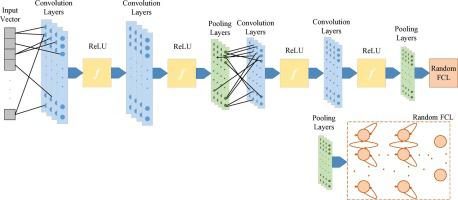Measurement ( IF 5.2 ) Pub Date : 2020-11-30 , DOI: 10.1016/j.measurement.2020.108794 Hatem Sindi , Majid Nour , Muhyaddin Rawa , Şaban Öztürk , Kemal Polat

|
Power loss allocation methods should be efficient enough to meet the needs of the customers on the bus and effectively calculate the losses from generators and consumers. In order to perform these tasks, a highly robust model is essential to distinguish between the effects of multi-consumers. This study presents a novel convolutional neural network (CNN) architecture that is highly effective for z-bus loss allocation. The proposed CNN architecture that uses the Z-bus matrix as input is 1D. Unlike traditional 1D CNN architectures in the literature, the fully connected layer (FCL) of the proposed method is randomized. Unlike Traditional FCL layers, randomized FCL's input weights and biases are not needed to be tuned. This makes the proposed 'Randomized Fully Connected Layered 1D CNN' architecture relatively fast and straightforward. Proposed Randomized Fully Connected Layered 1D CNN is trained in an end-to-end manner with a regression task for robust loss allocation. The performance of it is higher than other state-of-the-art methods. In addition to the fact that the proposed method's regression performance is very promising, the classifier performance is quite satisfactory thanks to the changes to be made in its output.
中文翻译:

随机全连接分层一维CNN解决Z总线损耗分配问题
功率损耗分配方法应足够有效,以满足公共汽车上客户的需求,并有效地计算发电机和用户的损耗。为了执行这些任务,高度健壮的模型对于区分多消费者的影响至关重要。这项研究提出了一种新颖的卷积神经网络(CNN)架构,该架构对于z总线损耗分配非常有效。使用Z总线矩阵作为输入的拟议CNN体系结构为1D。与文献中的传统一维CNN架构不同,该方法的全连接层(FCL)是随机的。与传统的FCL层不同,不需要调整随机FCL的输入权重和偏差。这使得提出的“随机化的全连接分层一维CNN”架构相对快速,简单。提出的随机化全连接分层1D CNN以端到端的方式进行训练,并带有回归任务以实现可靠的损失分配。它的性能高于其他最新技术。除了提出的方法的回归性能非常有前景的事实外,归功于分类器性能的提高,这要归功于其输出的变化。











































 京公网安备 11010802027423号
京公网安备 11010802027423号